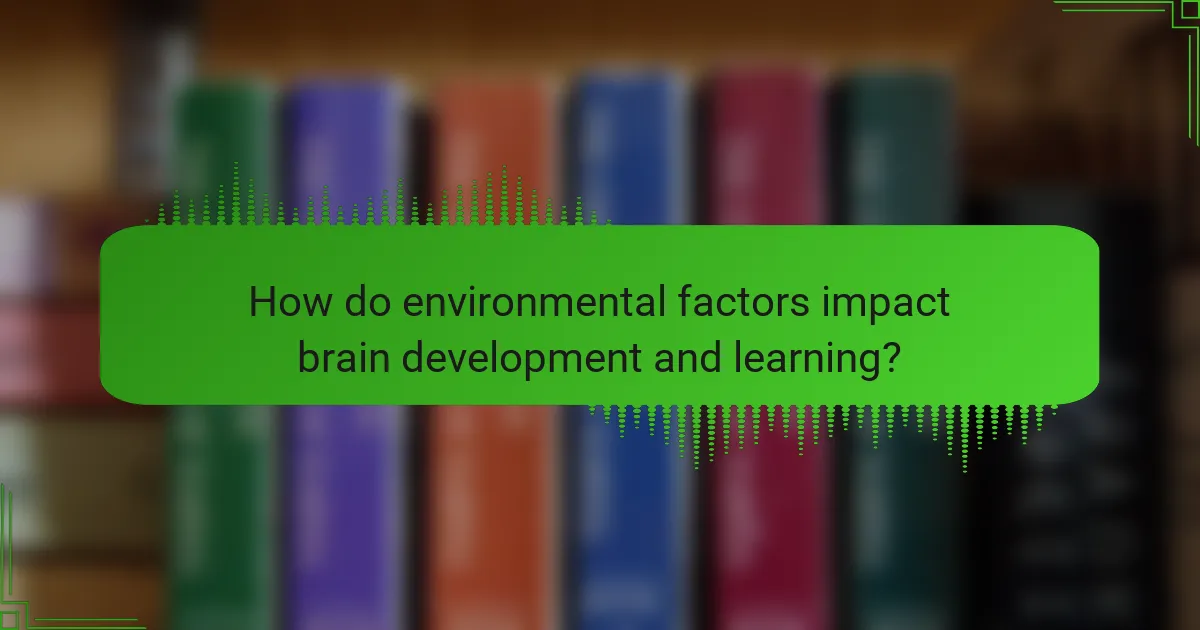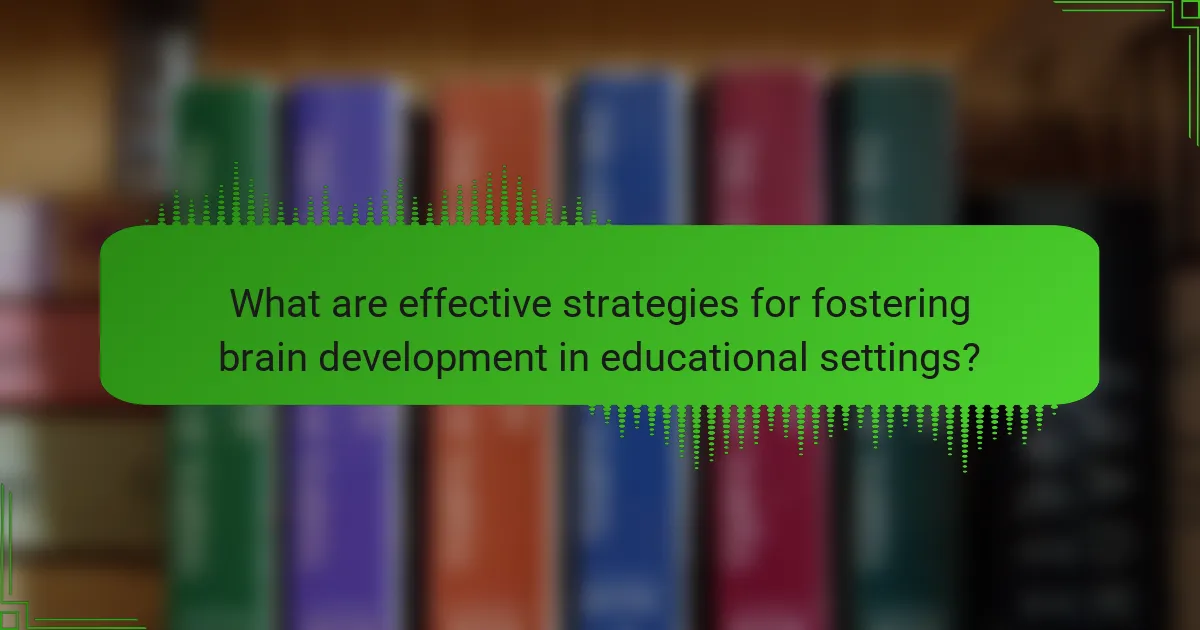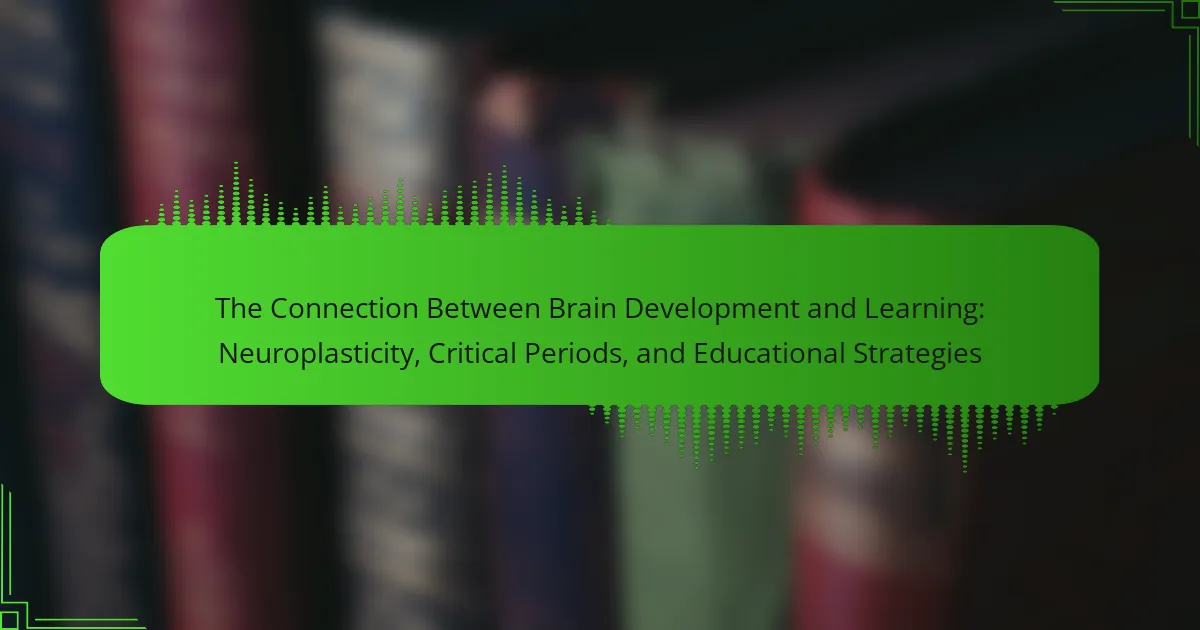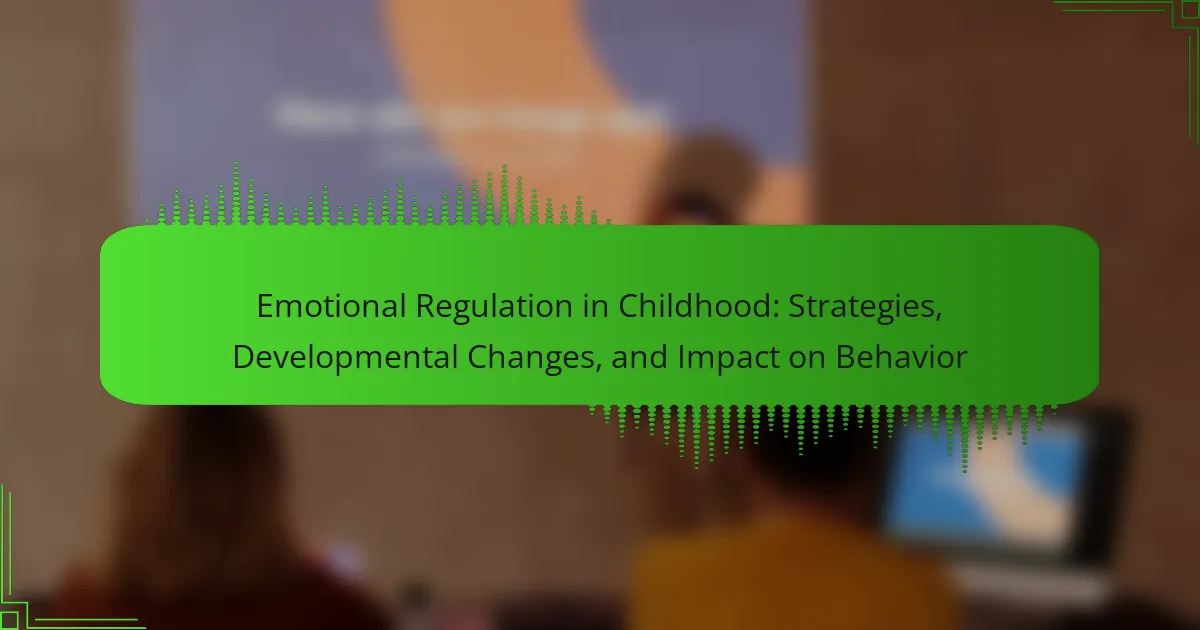Brain development is fundamentally linked to learning processes, with neuroplasticity playing a critical role in how the brain adapts and reorganizes in response to experiences. This article explores the impact of environmental factors, such as nutrition, exposure to toxins, and social interactions, on cognitive abilities and learning outcomes. It emphasizes the importance of effective educational strategies, including active learning, social interaction, and multimodal teaching approaches, which align with developmental stages to optimize brain growth. The discussion highlights how enriched environments can enhance neuroplasticity and improve academic performance, underscoring the need for tailored learning experiences that support cognitive development.

What is the connection between brain development and learning?
Brain development is closely linked to learning processes. As the brain matures, it forms neural connections essential for acquiring new knowledge. Neuroplasticity allows the brain to adapt and reorganize itself in response to experiences. This adaptability is crucial during critical periods of development, where specific learning experiences can have lasting impacts. Research shows that enriched environments enhance cognitive abilities by promoting brain growth. For instance, studies indicate that early childhood education can significantly influence brain structure and function. Therefore, effective learning strategies should align with developmental stages to optimize educational outcomes.
How does neuroplasticity influence learning processes?
Neuroplasticity influences learning processes by enabling the brain to reorganize itself through forming new neural connections. This ability allows individuals to adapt to new information and experiences. When learning occurs, synapses strengthen or weaken based on activity levels. This process is essential for acquiring new skills and knowledge. Research shows that engaging in challenging tasks promotes neuroplasticity. For example, studies indicate that individuals who practice a skill repeatedly can enhance their brain’s structure and function. Thus, neuroplasticity is fundamental for effective learning and memory retention.
What are the key mechanisms of neuroplasticity?
The key mechanisms of neuroplasticity include synaptic plasticity, neurogenesis, and functional reorganization. Synaptic plasticity refers to the strengthening or weakening of synapses based on activity levels. Long-term potentiation (LTP) and long-term depression (LTD) are specific forms of synaptic plasticity. Neurogenesis is the process of generating new neurons from neural stem cells, which is particularly active in the hippocampus. Functional reorganization allows the brain to adapt by reallocating functions to different areas following injury or learning. Evidence shows that enriched environments and learning experiences enhance these mechanisms, promoting cognitive flexibility and recovery from brain injuries.
How does neuroplasticity change with age?
Neuroplasticity decreases with age. In children, the brain exhibits high levels of plasticity, allowing for rapid learning and adaptation. This plasticity facilitates the acquisition of new skills and recovery from injuries. As individuals age, the brain’s ability to reorganize itself diminishes. Factors contributing to this decline include reduced synaptic plasticity and changes in neurotransmitter levels. Research shows that older adults experience slower cognitive processing and less efficient neural connections. Studies indicate that while neuroplasticity is still present in older adults, it is less robust compared to younger individuals.
What are critical periods in brain development?
Critical periods in brain development are specific time frames when the brain is particularly receptive to certain stimuli. During these periods, experiences can significantly shape neural connections. For example, visual and auditory systems have defined critical periods for optimal development. Research indicates that if appropriate stimuli are not received during these times, normal development may be hindered. Studies show that the first few years of life are crucial for language acquisition. The brain exhibits heightened plasticity during these critical windows, allowing for rapid learning and adaptation. Understanding critical periods can inform educational strategies to optimize learning outcomes.
Why are critical periods significant for learning?
Critical periods are significant for learning because they represent optimal windows for acquiring specific skills. During these times, the brain exhibits heightened plasticity, allowing for more effective learning. For instance, language acquisition is most efficient in early childhood. Research shows that children exposed to multiple languages before age seven can achieve native-like proficiency. After these critical periods, the ability to learn certain skills diminishes significantly. This phenomenon is supported by studies in neurodevelopment that highlight the importance of timing in learning processes.
What factors affect the duration of critical periods?
The duration of critical periods is affected by genetic, environmental, and experiential factors. Genetic factors include the specific genes that regulate brain development and plasticity. Environmental factors involve sensory experiences and exposure to stimuli during these periods. Experiential factors relate to individual learning opportunities and social interactions. Research indicates that early exposure to language influences the timing of critical periods for language acquisition. Studies show that enriched environments can extend critical periods by enhancing neural connectivity. Conversely, deprivation can shorten these periods and negatively impact development.
How do educational strategies leverage brain development?
Educational strategies leverage brain development by utilizing principles of neuroplasticity. Neuroplasticity refers to the brain’s ability to reorganize itself by forming new neural connections throughout life. Effective educational strategies, such as active learning and collaborative problem-solving, stimulate these neural pathways. For example, engaging students in hands-on activities enhances memory retention and understanding. Research shows that varied teaching methods can improve cognitive flexibility, which is crucial for adapting to new information. Additionally, addressing critical periods in brain development can optimize learning outcomes. Tailoring educational approaches to align with these developmental stages can significantly enhance a student’s ability to learn and retain information.
What teaching methods align with neuroplasticity principles?
Teaching methods that align with neuroplasticity principles include active learning, spaced repetition, and multimodal instruction. Active learning engages students through discussions and problem-solving. This method enhances neural connections by requiring students to apply knowledge in various contexts. Spaced repetition reinforces memory retention by revisiting material over time. Research indicates that this technique leverages the brain’s ability to strengthen synapses through repeated exposure. Multimodal instruction incorporates visual, auditory, and kinesthetic elements. This approach caters to different learning styles and promotes greater engagement, which is crucial for neuroplastic changes. These methods collectively support the brain’s adaptability and enhance learning outcomes.
How can educators utilize critical periods effectively?
Educators can utilize critical periods effectively by recognizing and targeting specific developmental windows for learning. Critical periods are times when the brain is particularly receptive to certain types of learning. For instance, language acquisition is most effective in early childhood. During this time, children’s brains can absorb new languages more naturally.
Research shows that children exposed to multiple languages before the age of seven have a greater chance of achieving native-like proficiency. Additionally, educators can enhance social-emotional learning during early years. This is crucial for developing interpersonal skills and emotional regulation.
Structured environments that promote exploration and interaction are beneficial during these periods. Activities that engage multiple senses can also optimize learning outcomes. Understanding the timing of critical periods allows educators to tailor their teaching strategies. This can lead to more effective learning experiences.

How do environmental factors impact brain development and learning?
Environmental factors significantly influence brain development and learning. These factors include nutrition, exposure to toxins, and social interactions. Proper nutrition during critical developmental periods supports cognitive function. A deficiency in essential nutrients can lead to impaired brain growth and learning deficits. Exposure to environmental toxins, such as lead, has been linked to reduced IQ and attention problems. Additionally, positive social interactions promote neural connections and cognitive skills. Studies show that enriched environments enhance neuroplasticity, facilitating learning. Research from the National Institute of Health indicates that children in stimulating environments perform better academically. Thus, environmental factors play a crucial role in shaping brain development and learning outcomes.
What role does early childhood experience play in brain development?
Early childhood experience plays a crucial role in brain development. During this period, the brain undergoes rapid growth and forms essential neural connections. Experiences such as nurturing, stimulation, and social interaction significantly influence this development. Positive interactions promote healthy brain architecture, while negative experiences can lead to adverse effects. Research shows that 90% of brain growth occurs by age five. This growth sets the foundation for cognitive, emotional, and social skills. Furthermore, critical periods exist when the brain is particularly receptive to learning. These experiences shape the brain’s structure and function, impacting lifelong learning and behavior.
How does stimulation affect cognitive growth?
Stimulation positively affects cognitive growth by enhancing neural connections in the brain. Increased stimulation encourages the development of synapses, which are crucial for learning and memory. Research indicates that enriched environments lead to improved cognitive outcomes. For instance, studies show that children exposed to stimulating activities demonstrate higher IQ scores. Additionally, stimulation can activate different brain regions, promoting diverse cognitive skills. Engaging in problem-solving tasks and creative play significantly boosts cognitive flexibility. Overall, stimulation is essential for optimal cognitive development and lifelong learning.
What are the consequences of neglect on brain development?
Neglect has significant consequences on brain development. It can lead to reduced brain size and altered brain structure. Studies show that children who experience neglect exhibit lower volumes in critical areas like the prefrontal cortex and hippocampus. These regions are essential for learning, memory, and emotional regulation. Neglect can also disrupt the formation of neural connections. This disruption impacts cognitive and emotional development. Research indicates that children with a history of neglect may face long-term challenges in academic performance and social relationships. The effects can persist into adulthood, affecting mental health and overall well-being.
How can socio-economic status influence educational outcomes?
Socio-economic status significantly influences educational outcomes. Higher socio-economic status often provides access to better educational resources. These resources include quality schools, experienced teachers, and advanced learning materials. Students from lower socio-economic backgrounds may face challenges such as inadequate school facilities. They might also lack access to extracurricular activities that enhance learning. Research shows that children from low-income families score lower on standardized tests. A study by the National Center for Children in Poverty found that children in poverty are less likely to graduate from high school. Additionally, socio-economic status can affect parental involvement in education. Parents with higher education levels often engage more with their children’s schooling. This involvement is crucial for academic success. Overall, socio-economic status creates disparities in educational opportunities and outcomes.
What barriers do low-income families face in supporting learning?
Low-income families face several barriers in supporting learning. Limited financial resources restrict access to educational materials and extracurricular activities. High levels of stress associated with financial instability can negatively impact parental involvement. Lack of stable housing often leads to frequent school changes, disrupting continuity in education. Limited access to technology hampers children’s ability to engage with digital learning tools. Additionally, parents may lack time due to multiple jobs, reducing their capacity to assist with homework or school projects. These barriers collectively hinder the educational support low-income families can provide.
How can community resources enhance learning opportunities?
Community resources enhance learning opportunities by providing access to diverse educational tools and experiences. These resources include libraries, community centers, and local organizations. They offer workshops, tutoring, and mentorship programs. Such programs can improve academic performance and foster critical thinking skills. Research indicates that students engaged with community resources show higher levels of motivation and achievement. For example, a study by the National Education Association highlights the positive impact of community involvement on student success. Community resources also encourage collaboration and social interaction, which are essential for cognitive development.

What are effective strategies for fostering brain development in educational settings?
Effective strategies for fostering brain development in educational settings include active learning, social interaction, and multimodal teaching approaches. Active learning engages students in hands-on activities, which enhances cognitive processing. Research shows that students retain 75% of information when they teach others, highlighting the importance of peer teaching. Social interaction promotes emotional and cognitive growth. Collaborative group work encourages communication skills and critical thinking. Multimodal teaching incorporates visual, auditory, and kinesthetic learning styles. This approach caters to diverse learners and improves retention. Additionally, providing a stimulating environment with varied materials can enhance curiosity and exploration. These strategies align with principles of neuroplasticity, supporting brain development throughout educational experiences.
How can educators create a brain-friendly learning environment?
Educators can create a brain-friendly learning environment by incorporating strategies that align with how the brain learns best. This includes utilizing a variety of teaching methods to engage different learning styles. For instance, blending visual, auditory, and kinesthetic activities can enhance retention.
Maintaining a positive and supportive classroom atmosphere fosters emotional safety, which is crucial for effective learning. Research shows that stress negatively impacts cognitive function, so reducing anxiety through encouragement is beneficial.
Incorporating regular breaks allows the brain to rest and recharge. Studies indicate that short breaks can improve focus and productivity. Additionally, providing opportunities for collaborative learning encourages social interaction, which enhances cognitive development.
Lastly, integrating real-world applications of knowledge can make learning more relevant and engaging. This approach helps students see the practical value of what they are learning, reinforcing their motivation to engage with the material.
What practices promote engagement and motivation in students?
Active learning practices promote engagement and motivation in students. These practices include collaborative group work, hands-on activities, and interactive discussions. Research shows that students are more engaged when they participate actively in their learning process. For instance, a study by Prince (2004) found that active learning increases student performance in STEM subjects. Additionally, providing timely feedback enhances motivation by helping students understand their progress. Setting clear goals also fosters a sense of achievement, which boosts motivation. Incorporating technology can create dynamic learning environments that engage students further. Overall, these practices are effective in promoting both engagement and motivation in educational settings.
How can collaboration enhance learning experiences?
Collaboration enhances learning experiences by fostering deeper engagement and understanding among participants. When individuals work together, they share diverse perspectives and skills. This exchange of ideas promotes critical thinking and problem-solving abilities. Research shows that collaborative learning environments can lead to higher academic achievement. A study published in the Journal of Educational Psychology found that students in collaborative settings outperform those in traditional classrooms. Collaborative learning also improves communication skills, as individuals must articulate their thoughts clearly. Furthermore, it builds social skills and emotional intelligence, which are crucial for personal and professional success. Overall, collaboration creates a dynamic and interactive learning atmosphere that benefits all participants.
What are some best practices for parents to support brain development?
Parents can support brain development by engaging in interactive play with their children. This type of play stimulates cognitive growth and enhances problem-solving skills. Reading to children regularly fosters language development and comprehension abilities. Providing a balanced diet rich in omega-3 fatty acids supports neural function and overall brain health. Encouraging physical activity promotes blood flow to the brain, which is essential for cognitive performance. Establishing a consistent sleep schedule aids memory consolidation and learning. Limiting screen time allows for more opportunities for creative and social interactions. These practices are supported by research indicating that early childhood experiences significantly influence brain architecture and cognitive outcomes.
How can parents encourage neuroplasticity at home?
Parents can encourage neuroplasticity at home by providing a stimulating environment. Engaging activities like puzzles and games promote cognitive challenges. Regularly introducing new experiences enhances brain adaptability. Physical exercise increases blood flow to the brain, fostering growth. Encouraging social interactions supports emotional and cognitive development. Mindfulness and meditation practices can improve focus and mental flexibility. Reading together stimulates language skills and imagination. Offering a variety of learning opportunities nurtures curiosity and exploration.
What activities can strengthen learning during critical periods?
Engaging in interactive and stimulating activities can strengthen learning during critical periods. Activities such as problem-solving games enhance cognitive skills. Social interactions promote language development and emotional intelligence. Physical exercise has been shown to improve brain function and memory retention. Music education fosters creativity and enhances auditory processing. Structured play encourages exploration and critical thinking. Research indicates that these activities support neuroplasticity, which is crucial during formative years. The findings from studies show that early exposure to diverse experiences positively influences brain development.
What practical tips can educators implement to optimize learning?
Educators can optimize learning through various practical tips. Implementing active learning strategies enhances student engagement. Techniques such as group discussions and hands-on activities promote deeper understanding. Incorporating technology, like educational apps, can personalize learning experiences. Providing timely feedback helps students identify areas for improvement. Establishing a growth mindset encourages resilience and motivation in learners. Structuring lessons with clear objectives aids in focus and retention. Utilizing formative assessments allows educators to adapt teaching methods effectively. Creating a supportive classroom environment fosters collaboration and trust among students.
The main entity of the article is the connection between brain development and learning, specifically focusing on neuroplasticity, critical periods, and educational strategies. The article explores how brain maturation influences learning processes, highlighting the role of neuroplasticity in forming neural connections and adapting to experiences. It discusses critical periods in development when the brain is particularly receptive to learning, and outlines effective educational strategies that leverage these insights to enhance cognitive growth. Additionally, the article examines environmental factors, socio-economic status, and practical tips for parents and educators to support brain development and optimize learning outcomes.



